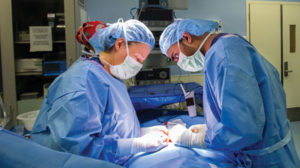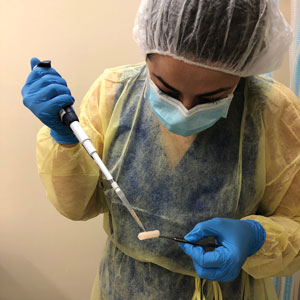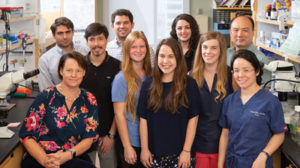
Article courtesy of CHLA.org
Tracy Grikscheit, MD, is a fixer. In the operating room at Children’s Hospital Los Angeles, she specializes in helping babies born with severe bowel dysfunction. She’s one of the leading pediatric surgeons specializing in intestinal disorders, and saving the lives of infants is a major part of her job.
Grikscheit, an attending surgeon at CHLA, often operates on babies born with an intact intestine that is not functioning adequately. The infants’ intestines are either missing or deficient in the crucial nerves and other supporting cells needed to produce muscle contractions that move food through the gut, and ensure proper digestion, nutrient absorption and waste disposal.

This group of disorders, called enteric neuropathies, is named for the enteric nervous system (ENS), a complex, tangled web of nerves within the intestine that is needed not only for the gut’s motility but also for essential gut hormone secretions and blood flow.
Without the ENS, stool becomes immobile—stuck in the intestine—and causes pain, gastrointestinal symptoms and infections. Individuals can be born without some or all of these neuronal cells layered within the intestine. The cells can also be injured or destroyed after birth, sometimes as a result of other diseases or conditions.
This is what Grikscheit has set out to fix.
Limited options for some babies

“The ENS is an incredibly diverse neural network that some call the second brain,” says Grikscheit, who is also an associate professor of Surgery at the Keck School of Medicine of USC. “It acts as traffic signals for the intestine and is also like a watchman for the neighborhood, making sure the intestine is happy and healthy.”
Right now, Grikscheit’s options in the operating room are limited. She can remove sections of intestine that lack nerve function while retaining the part that works. But even after one or more surgeries, most of these babies will continue to experience difficulties with bowel movements and be left prone to intestinal infections—some of which can be fatal.
And for the rare infant born with no enteric nervous system at all, the only option is an entire intestinal transplant—which has only a 50 percent chance of success. There are no other treatments for the underlying cause of these disorders.
This is not good enough for Grikscheit, who heads a regenerative medicine laboratory focused on tissue engineering within The Saban Research Institute of CHLA.
Potential treatment for all babies

Grikscheit and her team are working on a potential fix—a cell-based therapy that could help virtually any infant with this disorder.
Together, the team has developed a process that takes human pluripotent stem cells—a type of cell derived from adult cells and capable of becoming any type of specialized cell—and differentiates them into precursors for the missing nerve cells essential for proper intestinal function.
The cells would sit in the freezer and could be thawed and delivered into a newborn baby missing some or all of the enteric neurons. Just as they would in normal development in utero, the cells would begin to differentiate and migrate down the length of the intestine, rebuilding the enteric neuronal network.
Outside of Grikscheit’s lab, other cell therapies in development are derived from individual patients. But custom-made therapies can be prohibitively expensive, and the process to retrieve a patient’s cells, revert them to stem cells and then differentiate them into enteric precursors would take months—too long for a newborn with a blocked bowel to wait.
Instead of trying an individualized method, Grikscheit and her team are developing cells that could be used to treat any baby. To develop the therapy, called advanced stem cell enteric neuropathy therapy (ASCENT), Grikscheit received a grant last year for $7.1 million from the California Institute for Regenerative Medicine (CIRM) Translational Research Program.
Proof of concept
Together with a collaborator, Jason Spence, PhD, at the University of Michigan, Grikscheit recently added the enteric neural progenitor cells to a human tissue-engineered intestine, demonstrating that the progenitor cells could restore nervous-system function to a lab-grown human intestine. The engineered intestine was able to produce the movements needed for normal gut function. “This was a proof of concept that we can introduce a new nervous system into an organ that didn’t previously have one and that the two can function together,” says Spence.
Grikscheit is now working to show that adding the progenitor cells into animal models without an ENS can also restore intestinal function. The evidence is promising. Her lab already has shown that, when injected into the intestines of pigs, the cells are able to migrate and differentiate into at least some of the ENS cell types.
Progressing toward a clinical trial

Her lab is also busy preparing quality-control measures on the enteric progenitor cells to make sure that a sufficient quantity and quality of cells can be made to begin a first-in-human clinical trial.
The trial would test whether these cells, when injected into the small intestine, could migrate and differentiate, establishing the ENS. Initially, testing would be performed in a small number of infants with severe cases of enteric neuropathies, such as Hirschsprung disease.
The trial would be notable—the first pediatric trial investigating a cell-based therapy derived from pluripotent stem cells, and the first therapy of any kind to be tested for enteric neuropathy.
“When I speak to parents, the thing they want to know is when I can fix their child,” says Grikscheit. With her breakthrough research and translational work, she hopes she will have a much better answer for them soon.
